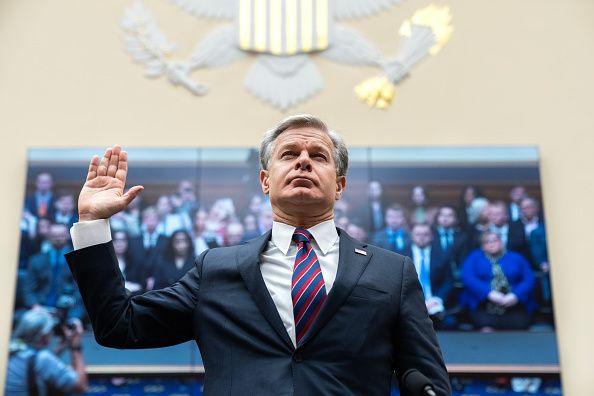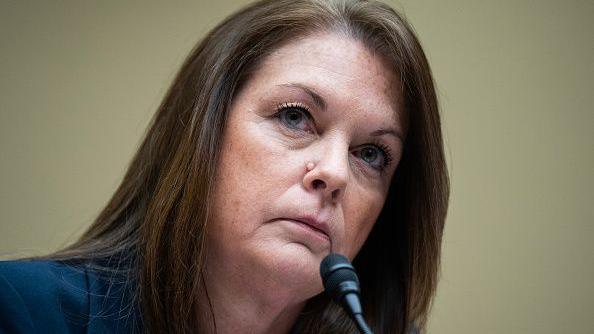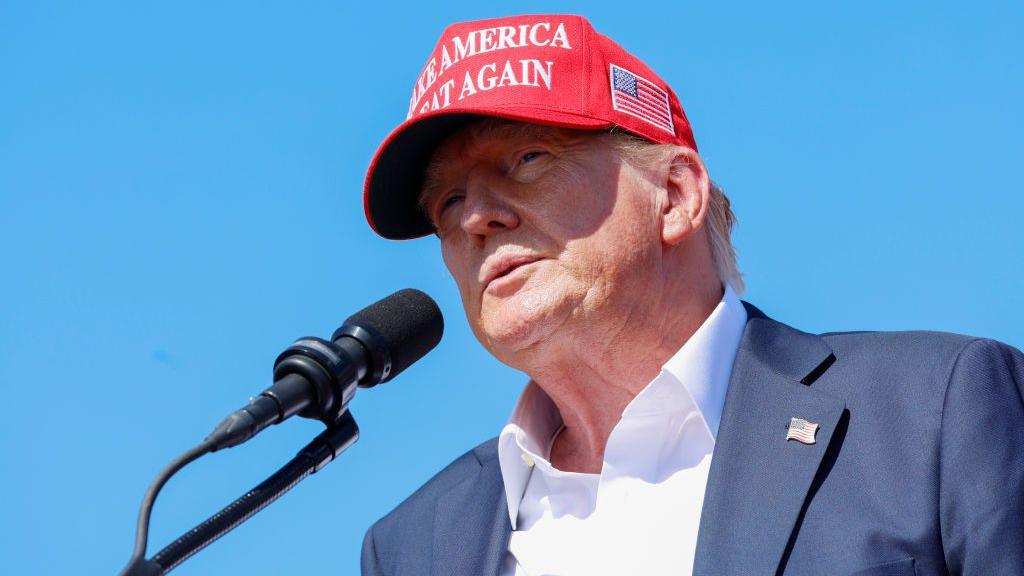Trump rally gunman searched online for JFK assassination details

US Secret Service agents draw their weapons in the moments after Matthew Crooks fired a weapon at a Pennsylvania rally
- Published
The gunman who targeted Donald Trump at a campaign rally earlier this month researched the assassination of John F Kennedy in the days before the shooting, FBI Director Christopher Wray has said.
Mr Wray testified on Wednesday before the House Judiciary Committee about the 13 July shooting at the Butler, Pennsylvania, campaign.
A bullet grazed Trump's right ear and the attack left one rally audience member dead and two others badly wounded.
The gunman also used a firearm with a "collapsible stock", likely making it easier to conceal, Mr Wray said.
In his opening remarks, the FBI director called the attempted assassination of Trump "an attack on our democracy and our democratic process".
"We will not and do not tolerate political violence of any kind, especially a despicable account of this magnitude," he told lawmakers.
Mr Wray said that on 6 July - a week before the shooting - the gunman searched "how far away was Oswald from Kennedy" online and registered for the Trump rally.
Lee Harvey Oswald shot and killed President Kennedy in 1963.
The FBI head said on Wednesday that the agency still does not have a motive for the assassination attempt but the gunman appears to have become "very focused" on Trump a week before the shooting.
Investigators also found the gunman had conducted searches for news articles about other public figures.
Mr Wray said the shooter fired at least eight shots. Officials recovered eight cartridges on the roof where the gunman, identified as 20-year-old Thomas Matthew Crooks, was located.
Crooks was killed by a counter sniper during the incident.
The AR-style rifle used in the shooting had a collapsible stock, which can make a weapon shorter and easier to transport.
The first people to see the gunman with a rifle did so when he was already on the roof from where he fired, Mr Wray said. He added that a local officer observed the gunman seconds before he fired shots.
Investigators are working to determine whether Crooks took the gun onto the roof or if it was placed there in advance.
The FBI director also confirmed that the gunman flew a drone over the rally about two hours before the shooting.
Additionally, the FBI found three "relatively crude" explosive devices - one in the gunman's home and two others in his car.
These devices were capable of being detonated remotely and the gunman had a transmitter, Mr Wray said.
It did not appear as if the Crooks would have been able to detonate them from the roof where he was perched at the time of the shooting, he added.
The investigation also revealed the gunman went to a shooting range, where he fired an AR-style rifle, the day before the rally. The FBI believes it to be the same weapon used in the assassination attempt.

Mr Wray said there is no evidence that the gunman planned the attack with others.
Investigators are exploring a number of Crooks' digital devices, he said, adding that the shooter meets the description of a "loner" and had few contacts in his phone.
Upon searching his home, officials found about 14 firearms associated with him and his family.
The FBI is handling the criminal investigation into the attempted assassination and Mr Wray told the committee the agency will "leave no stone unturned".
"The men and women of the FBI will continue to work tirelessly to get to the bottom of what happened," he said.
Secret Service Director Kimberly Cheatle resigned from her position on Tuesday after testifying before a different congressional committee earlier this week.
She faced calls from both Democrats and Republicans to step down after the contentious hearing, during which lawmakers became increasingly frustrated after she refused to answer questions about the attempted assassination.
Related topics
- Published24 July 2024

- Published24 July 2024

- Published15 July 2024
